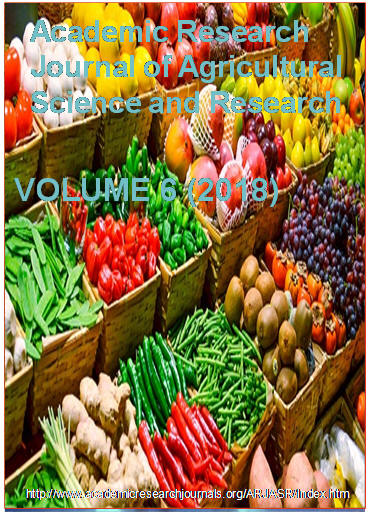| ARJASR |
Academic Research Journal of
Agricultural Science and Research |
|||||||||||||||||||
|
Vol. 6(8), pp. 453-463. October, 2018. ISSN: 2360-7874 DOI: 10.14662/ARJASRD2017.089 Full Length Research Sustainable land management practices and their impact on soil organic matter content and other chemical parameters, the case of Northern Ethiopia
Roza Ayalkibet1, Tesfay Araya2, Wim M. Cornelis2
1Ambo University, Department of Plant Science, POBox 19, Ambo Ethiopia 2University, Department of Soil Management, Coupure Links 653, B-9000 Gent, Belgium 2Department of Agronomy, University of Fort Hare, PBX1314, Alice 5700, South Africa b 2Mekelle University, Department of Crop and Horticultural Science, POBox 231, Mekelle, Ethiopia. *Corresponding author: rozaayalkibet@yahoo.com
Accepted 27 August 2018
Land management practices have a major impact on soil chemical quality, agricultural productivity and land sustainability. Land use change and management affects soil chemical properties and resilience, which is directly related with sustainability of agriculture production. The importance of sustainable land management practices SLMPs applied in northern Ethiopia has not been evaluated in terms of their contribution for improving soil organic matter content and other soil chemical quality. The aim of this study was to compare the impacts of different SLMPs on SOM content and other chemical parameters. Six types of SLMPs (area closure AC, crop rotation CR, conventional tillage CT, grazing land GL, conservation agriculture (DER+) and fallow land FL) were selected and arranged in a randomized complete block design with three replications on Vertisols and Leptosols. Soil texture, soil organic matter, total nitrogen, available phosphorus and soil structure stability index were measured. SOM and total N were significantly higher (p <0.05) on AC under both types of soil followed by CA, it was lower in GL and CR in Leptosols. In Leptosols the amount of available P were significantly higher than the rest land management. Except AC on Vertisols, which showed a value (8.99%) greater than the critical limit for soil structural degradation but the other land management in both soil types the value of soil structure stability were below the critical limit for land degradation. So soil on GL and CT needs urgent management changes in order to obtain good quality and maintain soil resilience. Generally, the importance of AC, CA and FL in improving and restoring SOM, total N, available P and, thus increasing crop productivity, land sustainability and maintaining long-term land resilience thereby avoiding further land degradation. However, the improvement in organic matter content and others chemical properties cannot seen immediately and the full benefit of AC, CA and land fallowing can only be expected after several years.
Keywords: Conservation agriculture, Soil resilience, Vertisols, Leptosols, Crop rotation, Fallow land Grazing land, Soil structural index, Soil organic matter
How to cite this article (APA Style): Ayalkibet, R., Araya, T., Cornelis, W.M. (2018). Sustainable land management practices and their impact on soil organic matter content and other chemical parameters, the case of Northern Ethiopia. Acad. Res. J. Agri. Sci. Res. 6(8): 453-463 |
|||||||||||||||||||
